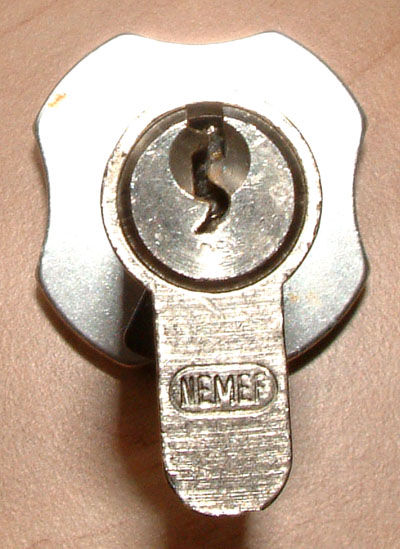A friend of mine asked if I could help him with a lock. The specifications were: I have to be able to lock it from the inside with a knob, and I will not use the key on the outside at all. It is a pretty security aware friend, and he wanted to use a pick- and bumpproof lock. So I gave him the lock you see below. Guaranteed pick and bump proof!
Can you see why?

pickproof lock ... can you see why?
Ok, here is what I did: I drilled out three of the caps that hold the springs and pins in place, and replaced the pins with a steel screw. Of course I cut the remaining head of the screw off using an abrasive wheel. If you look closely into the keyway you can see the thread of the screw instead of a smooth pin. Now, I am the first to admit the lock can not be opened from the outside at all, but that was the specification. Because of the steel screws I think the lock is a little bit more difficult to drill and pull out also …
More news soon, as I am still busy and still exploring the new features of this version of the wordpress blog software.

it’s not really a lock any more, it it?
Still, totally within specs, good thinking!
The thing Your friend asked for was called a “bolt”. It has been used for a few thousand years and is known to resist drilling, bumping, pulling and crowbars if the door is strong enough.
jos, it is a locking device 😉
Barry, according to the specs, you could also put a knob on a metal plate 😉
Erm, so is a padbar. And a portcullis. What I don\’t see is a moat?
And what a waste of a Nemef. Those things are like mogul’s here in the States.
You did it the hard way and made a completly fucked lock.
The simple way would have been to make a what I call a lockbreaker, its just any key that will fit the keyway that is modified so that all the slopes that allow the pins to ride up as you pull they key out are cut to 90 degrees, so that there are no slopes, for pulling it out,
You could even have made a blank with some straight down slot cuts to trap the pins from going in either direction, this needs a needle probe to lift all the pins then you insert the lockbreaker, pull out the probe while holding this key in, then break off the keybow. In this way, you can just walk up to a lock and insert a lockbreaker and no ones going to use a key there, but someone like me could still salvage the lock some day by cleaver use of very thin shims to lift those pins and reinsert the straight probe.
Both yours and rai’s solution are good field expedient techniques. I think ideally, you would either replace the door with one designed for the purpose/without a prepared hole for the euro, or would use a blank Euro body made from HSS or Hardplate W/E(keeping the solution sane considering the door the plug would be mounted to.) Built in alarm sensors are always a plus.
Alternatives to screws would be to intentionally break a tap/easy out/drill bit off in the lock.
if someone will try to drill this lock, the steel screw will simply act as a steel pin.
once you’ve drilled through the sheer line, the plug will rotate.
a superglued lock, on the other hand, will not.
the only way to drill the lock then will be to ‘eat’ the entire plug with a carbide burr..
You could leave them like some of the locks I see, with (half) a drill bit sticking out of them. Pretty much impossible to do anything with!
The fastest and easiest way to have done this would have been to shove some superglue to glue the plug to the hull, then fill the rest of the space with epoxy down the keyway. Drive a hardened steel screw down it before it has set, and then mangle the drive head so it can’t be unscrewed. Unbeatable.